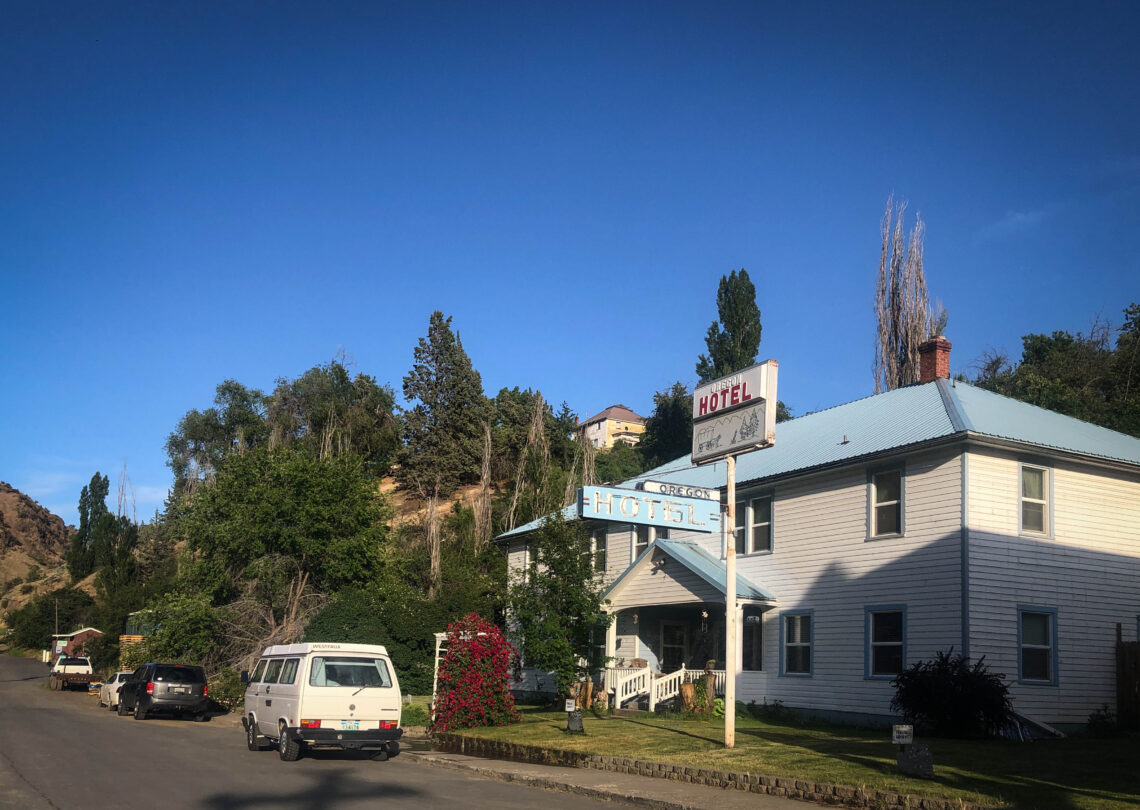
Cultured
Local culture is hard to distinguish from digital imperialism.
I woke up here in Mitchell, Oregon still marveling at what the tech workers in Prineville have chosen to make out of it. It was just about abandoned the first time I ever saw it, but I suppose it is convenient for people finding something to do out of town for a day or two. It is deliberately funky, but does have a brewpub with a big patio.
Longest day of the year, probably, and I was duly awake at dawn, which was delayed by the steep hills closely surrounding Mitchell, but was nevertheless before five o’clock. I waited to see if I would fall back to sleep, but finally thought it might be interesting to go down to Janet parked on the street just in front of this old hotel and make my coffee in there.
The hay haulers were up and out of here by just before six am, going to Clem’s at the crossroads or wherever he mumbled when I asked one of them last night. Come down from Monument, they did. His dad taught him to breed half grass, half alfalfa and it kills the weeds. He must be living just as his dad did, and it hasn’t killed him. I had struck up a short conversation because they seemed like pre-tech locals, while I had a drink and snacks on the front porch in the pleasant evening.
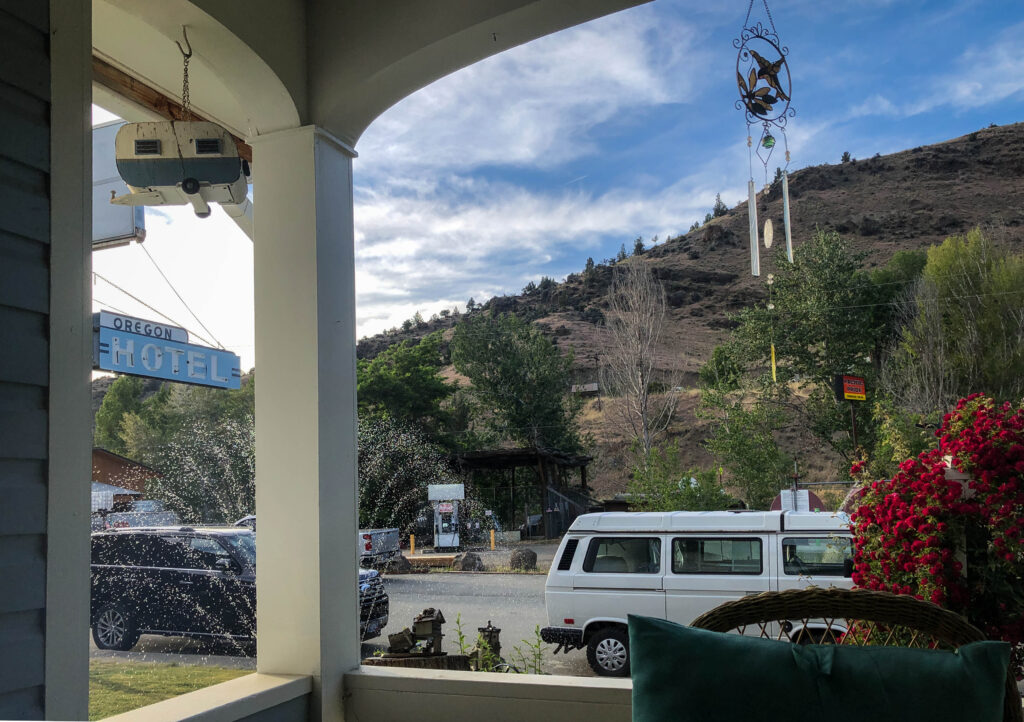 Speaking of pre-tech, after coffee I got back to my room, and got this computer out to write here, and it wasn’t until I was settled back under the covers and propped up against the headboard that I remembered there was wifi. It has taken less than a week for me to just sort of forget about whatever I think I’m going to find online. It would seem it is not all that important. It has really mattered to be able to live focused on what is in front of me, and to like focusing on what is in front of me, more importantly. Of course right now I have no urgent need to communicate with someone far away, but maybe if I did we could write letters.
Speaking of pre-tech, after coffee I got back to my room, and got this computer out to write here, and it wasn’t until I was settled back under the covers and propped up against the headboard that I remembered there was wifi. It has taken less than a week for me to just sort of forget about whatever I think I’m going to find online. It would seem it is not all that important. It has really mattered to be able to live focused on what is in front of me, and to like focusing on what is in front of me, more importantly. Of course right now I have no urgent need to communicate with someone far away, but maybe if I did we could write letters.
Yeserday we left Troy and started along the gravel road toward Elgin, which followed the Grande Ronde river as it looped through its canyon along pleasant meadows, and the occasional ranch. Then we left the Grande Ronde to its canyon and started up a side creek, which was in a small wooded canyon lined with wildflowers. The whole drive to the Wallowa valley was lined with wildflowers, some I’ve never seen before. There was a crazy amount of butterflies of different colors. One even landed on Janet’s windshield wiper and would not go, and I didn’t want to hurt it so I stopped. I guess we like butterflies not just because they’re pretty and flit about lazily, but because they arrive when there are a) flowers, and b) sunshine. All nice associations. So after I’d made that brilliant analysis, the road crossed the creek and started to climb.
It wasn’t as bad as going in. This road even had a few guardrails! And the worst turns, which indeed did look out over a deep canyon, also had little shoulders. And yes, this time we met a truck oncoming and yes it was going too fast and I saw the driver flinch as the truck jerked a little. How big a fool can you be? I can’t say I wanted to watch another person pitch over the edge, but right then the idea sounded a bit satisfying. As we gained the top of the plateau and drove through endless green meadows surrounded by tall Ponderosas and dotted with picturesque decaying old wooden ranch structures, I cooled off and pondered male idiocy. Every stupid, dangerous, harmful thing comes of it. Then I got to pondering Janet, and how everything to do with her, her invention, her design, her manufacture, her maintenance, her repair…was entirely, 100% due to men. I do appreciate that. Ok, and I guess if they want to kill themselves, or each other, they can, but leave us women out of it. And I just realized I just described to a T how traditional societies worked. A man would have been doing the driving for me, though how that is supposed to make me feel safer I’m not sure. I remember thinking long ago of all the things women probably invented or discovered, including agriculture. Of course some men maintain that is what started their enslavement, and they may be right. But women also, no doubt, invented beer and bread, so men can have that and quit complaining.
I’d had some ideas for new routes through isolated places on my way home, but that arts section had had a couple of ads that caught my eye, for a bookstore and a bakery in Baker City, Oregon. There was also a full-color ad for an exhibit of paintings by a local Baker City boy made good, who made them just for this exhibit in his home territory. So today was going to be city exploring for a change, if just over ten thousand souls makes a city.
First stop in the Baker City downtown with bafflingly wide streets was the bakery. I had a very good meal there, and feeling very pleased, I asked the friendly middle-aged waitress some questions. Yes, she’d grown up in the area. No, the conservative mayor who had challenged the governor over the pandemic policies had not been booted out, but her supporters had booted out her predecessor, who was a friend. Then she said in a quiet voice that the town was very divided, and she didn’t like it.
I then asked about the bookstore. She perked up and said it was wonderful. It was full of the most comprehensive array of tripe I’ve yet seen prominently displayed in one bookstore. Clearly it had been established with a hippy/feminist slant, back in the good old 70s, and the owner is just another so-called rebel who failed to notice while her cause was so thoroughly co-opted by technocrat bankers as to be literally murderous. I meant to memorize the titles, but can only recite “I Know Why the Caged Bird Sings” and “Why I Don’t Talk (to White People) About Race.” Someone should write “I Know Why She Doesn’t Talk (to White People) About Race.” Anyway, our waitress, possibly tired of men driving too fast on twisty canyon roads, was clearly in the camp of the progressives, and felt bad about her friend getting booted out by the firebrand conservative lady. My research department discovered that the successor to the firebrand conservative lady was a conservative dipstick who rode in on her coattails. He got thrown out in less than a year for posting somewhere a swastika made out of rainbow flags. But I get the comment about the town being divided. And I did find two books to buy, one being the published writings of Abigail Scott Dunaway, from her newspaper in the 1870s that she ran in competition with her brother, who ran The Oregonian, still the state’s largest paper. A feminist when it wasn’t so easy.
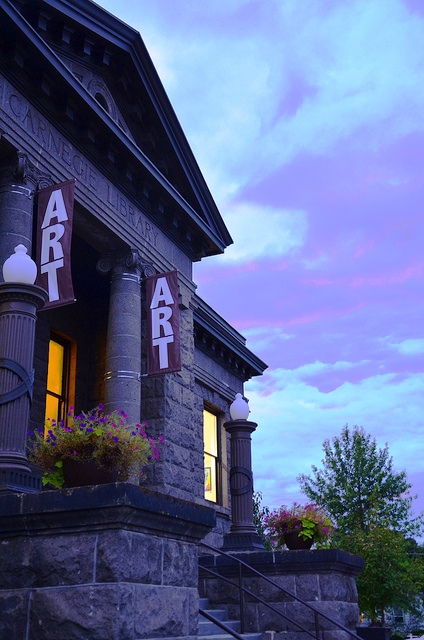
I was feeling very Oregonian, and continued on to the Carnegie Library that they have converted into an arts center, and that had lots of advertisements, including street banners on lampposts downtown, of the exhibition I was looking for. It was not evening, this photo of the library/arts center is cribbed off of a website. 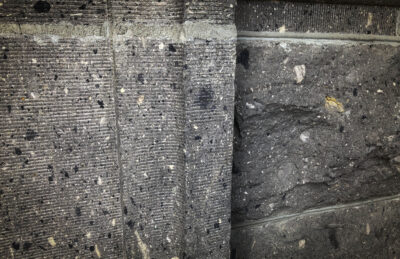
Approaching closer I was struck by the stone it is built of. Dark grey with many strange flecks and chunks of other stuff in it. It looked serious and sober with a dash of snazzy, like a grey pinstriped suit. When I entered, a woman greeted me with enthusiasm, and I asked her what kind of stone the library was built with. She said “Tuff!” This was an excellent answer. I have wondered if I have been seeing tuff sometimes, layered in the basalt. I asked if it was local stone, and she said she wasn’t sure how local, but that when they needed to do repairs they did find some that matched, that was a ways off.
The art was not good. I was disappointed. The best painting was the one they used for the ad. I thought, sure, he’s famous. All local boys are world class, ask any resident of Zenith.
But the middle-aged lady kept talking to me. She wanted to know where I’d been, where I was from, and just sort of made me feel awkward at keeping up my end of it while I just wanted to be amongst the paintings. She did tell me that there were more pictures of his life’s work downstairs and an overview of his story.
I freed myself long enough to look over all the paintings, because I had come willing to buy one if I liked it and it were not too expensive. I was even willing to spend $300 on one. They certainly did evoke Baker County, but no, I can find better on Etsy, frankly. Then in the other room there were a few lithographs from his earlier work, which had real merit. There was also a book by someone else of his work, with some nice plates of excellent paintings. Hmm.
Downstairs, I learned more. He had an exhibit in the Brooklyn Museum of Art, as a career highlight. He is featured in quite a few galleries, mostly in Utah, where he lives. He is in his 80s. I questioned his taste, since an array of his working men and women were ciphers with no faces and bodies like magazine models for American product ads. You should have seen hay grower in Mitchell this morning. A perfect example of nothing special. Muscle doesn’t come into farming much anymore, Iowa made that clear to me. Yikes. 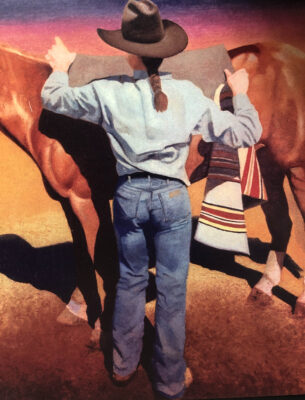
Anyway, upstairs the cheery woman cornered me one more time, and asked if I wanted to enter my name into a drawing for one of Mr. Smith’s paintings. It was sitting there, very tiny, say 5”x8”, where most in the exhibit are fairly large, say 3 feet or more on one side. I said ok, and as I was filling out my name and phone number I asked how much that little painting would sell for? She said $1,500. I didn’t hide my surprise, and she said, pointing back to the main exhibit area, “See that one with the hay? That one is $24,000.” Haha. Somebody knows how much money to burn our wealthy people have.
This arts center is, I suspect, foisting a lot of cultural ideas on the native inhabitants that they do not appreciate. It is obviously being funded from outside the area. But then Andrew Carnegie was probably doing the same thing a hundred years ago when he blessed them with a fancy library designed elsewhere. You can bet he had a say about what kind of books went into it.
Today, coming out onto the plain above Prineville, the Cascades were arrayed in their familiar row, all white with the recent snow against very blue sky. Herds of Black Angus cattle fed in deep green pastures. But as I imagined telling someone the name of each mountain, (from right to left, or north to south: Mt. Jefferson, Three Fingered Jack, Mt. Washington, The Three Sisters, Broken Top, Mt. Bachelor) a question occurred to me that I could not believe never had before. Why did the first explorers give the mountain with the most bulk and grandeur the name of Jefferson, and the spindly one a third of its size the name of Washington, the Father of Our Country?
There is a real political message there, and it feels as if it has some bearing on the tenor of this state, before it was a state. I know something of Jefferson’s feelings for Federalism and central banks, i.e. diametrically opposed to those of Alexander Hamilton. Which, being Washington chose him as his right hand man, tells me Washington didn’t care to support the agrarian independence idea to such a degree. Greed, greed, and more greed? But not as much, quite as much, in Oregon, the only West Coast state that had a farmland rush instead of a gold rush.

